Excerpts from Jim Conrad's
Naturalist Newsletter
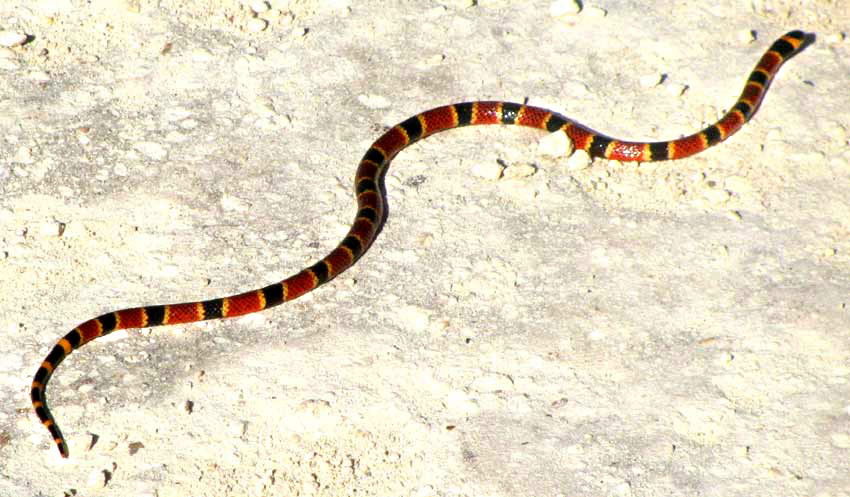
from the August 28, 2011 Newsletter issued from Mayan Beach Garden Inn 20 kms north of Mahahual; Caribbean coastal beach and mangroves, ~N18.89°, ~W87.64°, Quintana Roo state, MÉXICO
VARIABLE CORAL SNAKE
At 9AM on a certain morning I was biking the white sand road along the beach when I met what's shown above.
When you see any cross-banded, red, black and yellow snake you're supposed to think "coral snake." And you know that coral snakes are deadly. But you also know that coral snakes generally are nocturnal and, more importantly, the vast majority of cross-banded, red, black and yellow snakes people come into contact with are perfectly harmless mimics of coral snakes. However, there's a little folk rhyme to help us separate the real corals from the mimics. It goes like this:
In other words, if the snake's red bands are framed with narrow, yellow bands -- as in our picture -- it's a real coral. The more commonly encountered and harmless Tropical Milksnake looks just like a coral snake, except that its red bands are framed with black ones.
Actually, that rhyme works only in North America. Down here I've seen some coral mimics with red touching yellow. However, all the real corals I've seen do have their red touching yellow, so, so far, the rhyme works that way.
Our road-crossing snake was the Variable Coral Snake, MICRURUS DIASTEMA. It's very similar to the Eastern Coral Snake, Micrurus fulvius, of the US Southeast, and the "Texas Coral Snake," M. tener, which we met in Querétaro, and which is still on exhibition at www.backyardnature.net/q/coral.jpg.
In fact, I don't see any difference between these three species. It's just that experts say that they're different, and that what's in Querétaro is the "Texas Coral Snake" (though it's mainly a Mexican snake), and that what we have here is the Variable.
This is the first venomous snake I've seen at this location. And I was surprised to find a mostly nocturnal coral snake crossing a sun-drenched, white-sand road at 9AM. In the picture he's shining as if he's still wet, so maybe he was evacuating the mangrove swamp as it slowly continues to fill with water. He was traveling in the right direction for that.
from the March 11, 2006 Newsletter issued from Hacienda San Juan near Telchac Pueblo, Yucatán, México
VARIABLE CORAL SNAKE AT DUSK
Monday at dusk as I approached my lodging a two-ft-long Variable Coral Snake, MICRURUS DIASTEMA, lay upon the steps right before my door. Now that I've seen how that snake behaved, I'm more convinced that another snake recently encountered at dusk, also on some steps nearby, also was a coral. It had been too dark then for me to see the colors, but I clearly saw the shape, the banding and the behavior.
The behavior these two snakes shared was this: When the snakes grew agitated they squirmed much more vigorously than normal for escaping snakes on smooth surfaces, and ever couple of seconds they would suddenly launch their heads upwards and snap the air two or three times before falling back onto the ground and continuing to squirm.
Up north when I find rattlers, cottonmouths and copperheads in places where they might hurt people I put them into buckets and carry them to more isolated places. These snakes behaved far too violently and aggressively for me to fool with them, and they graciously escaped into the bushes before I could think too much about the matter.
Coral snakes are very dangerous. They're in the same snake family as cobras and mambas. Because of their small heads I've been told that corals can't bite anything larger than a finger. However, my new field guide says that they're able to gape their mouths so wide that they can bite almost any part of the human body where the skin is loose enough to be even slightly pinched so it can be held in a bite. Now when I go out jogging before sunrise my ankles tingle in anticipation...
One more note: Our Variable Coral species, different from the Central American Coral which doesn't occur here, but possibly the same as the Mayan Coral Snake found to the southeast, is truly variable. The greatest variation is in the numbers, and therefore the widths, of its colored bands. Variable Corals in northern Guatemala south of here may have as many as 50 black bands, but here in the northern Yucatan they may have as few as 12, the red bands expanding at the expense of the other bands. In fact, the snake I saw Monday basically looked like a red snake with widely spaced black bands. I didn't have the presence of mind to count his black bands but surely there were no more than 12, and my impression was that there were fewer.
issued on July 24, 2019 from near the forest just west of Tepakán; elev. ~9m (~30 ft), N21.053°, W89.052°; north-central Yucatán state, MÉXICO
VARIABLE CORAL SNAKE EATS RINGED SNAIL-EATER
Yesterday, standing where the outside kitchen's concrete floor makes a corner with the stone hut, as I removed from my backpack my weekly supply of bottled water purchased in Tepakán, movement at my feet caught my eye. Right below me I saw what's shown below:
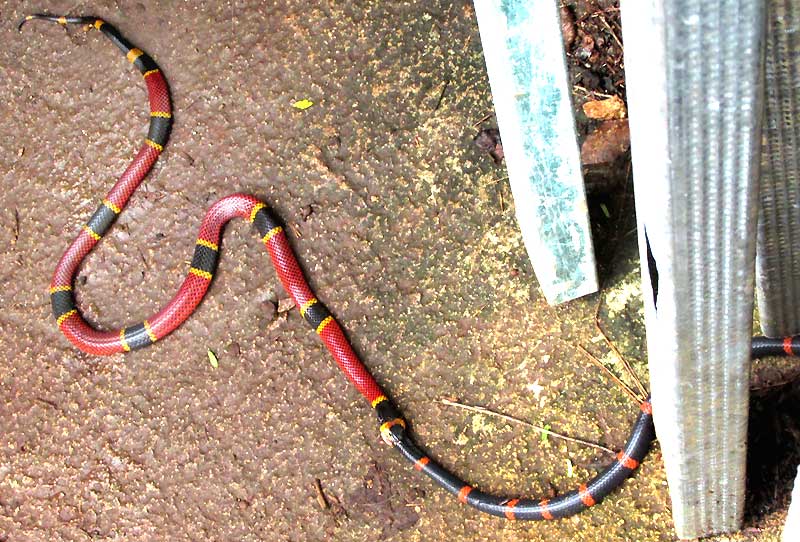
Next to a stacked bunch of aluminum bars being used to improve the hut, that's a Variable Coral Snake, MICRURUS DIASTEMA, eating a Ringed Snail-eater, SIBON SARTORII, the latter not a lot smaller than the former. Below, up closer, you can see the mechanics of the situation:
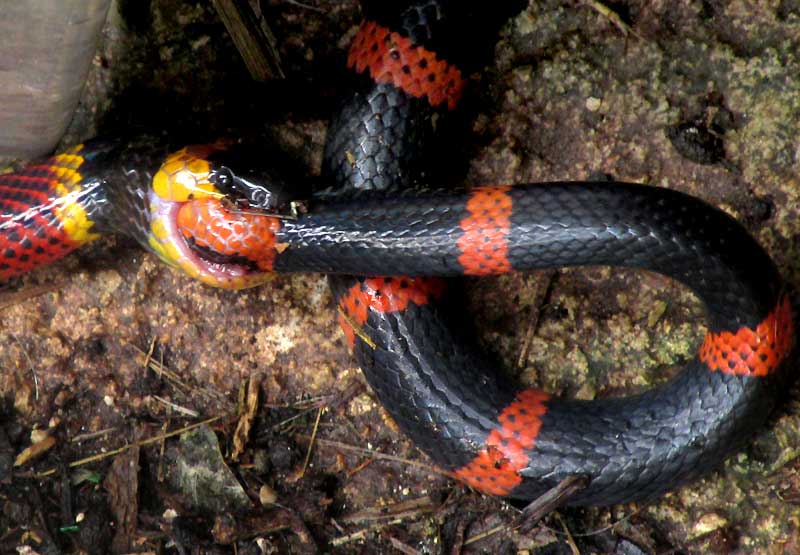
The coral snake has unhinged his jaws but, still, one wonders how the coral snake will be able to get all that snail-eater inside him. A closer view appears below:
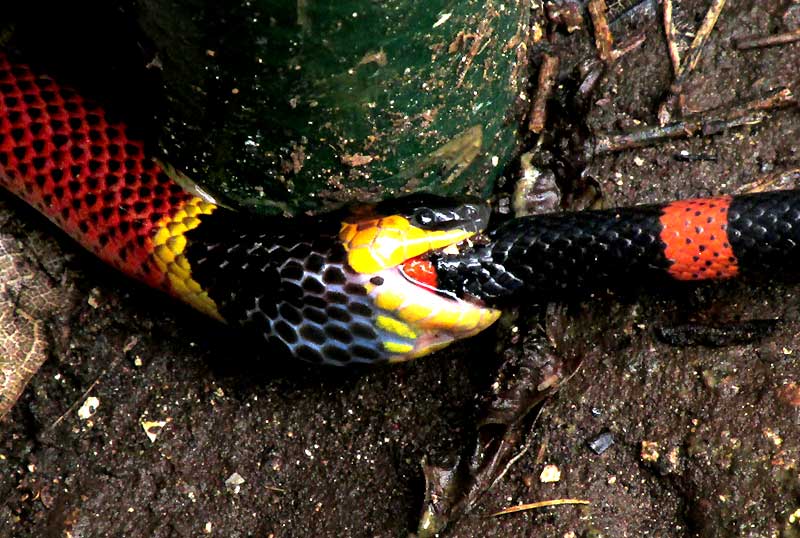
The drama had begun at 8:30AM. I suspect that the coral had just attacked the snail-eater as I walked into the area, for during my first close look I could still see an eye of the snail-eater in the coral's mouth-corner, and the snail-eater was squirming, the coral's venom not yet having done its work. For the first half hour, the swallowing process was very slow, hardly advancing at all. The coral would thrust his head forward, but usually no change could be seen in the snail-eater's disappearance.
After each lunge, which came at about two-minute intervals, the coral would pull on the snail-eater, who had his tail wrapper around an aluminum bar. Possibly the pulling caused the coral's fangs to sink deeper into the snail-eater's flesh. Also, corals are mostly nocturnal, the morning's light was growing more intense, and I was standing there taking pictures, so surely the Coral wanted to drag the victim into the less exposed situation among the bars or below the table. Also, with each lunge the coral's head turned a bit in a clockwise direction, so that during the entire lunging process the coral's head spiraled so that sometimes it was upside-down. In that half hour, about two head rotations were made, though most of the body didn't rotate.
After about half an hour of this lunging and pulling, with hardly any progress made in the swallowing process, the snail-eater stopped squirming, though his tail remained wrapped around the aluminum bar. Now the swallowing process sped up dramatically and the coral's head no longer turned. However, when maybe half of the snail-eater had been swallowed, a certain problem began developing for the coral, as shown below:
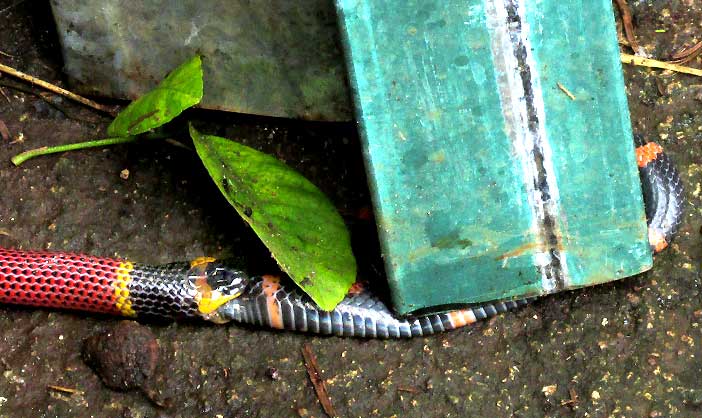
Though the snail-eater no longer resists, the rear part of its body has become wedged beneath the aluminum bar it earlier had been wrapped around. Below, you can see where the swallowing stalled and made no progress for about 45 minutes.
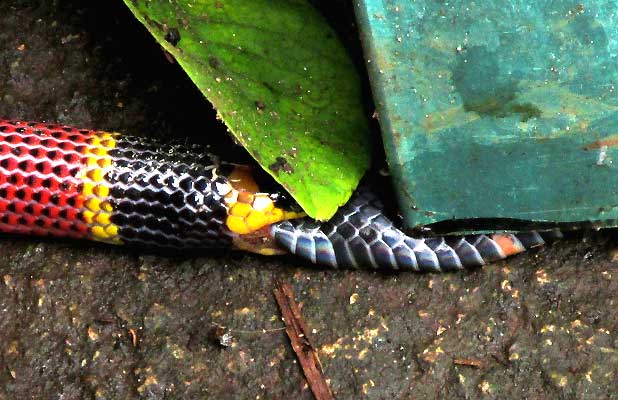
From time to time during this stalemate, despite the coral's clear aversion to exposing himself, several times he brought his body from behind the stacked bars and felt around with it, trying to find something to wrap its own tail around, and gain better purchase for pulling on the snail-eater. However, there was only the flat concrete floor, and decaying leaves piled by the wind here and there. Gradually the coral's body gathered leaves around its body, though I'm unsure whether it was incidental, or a conscious effort to hide himself. Below, you can see the resulting situation, the coral's body mostly hidden by leaves, while its own tail is wrapped around a bar:
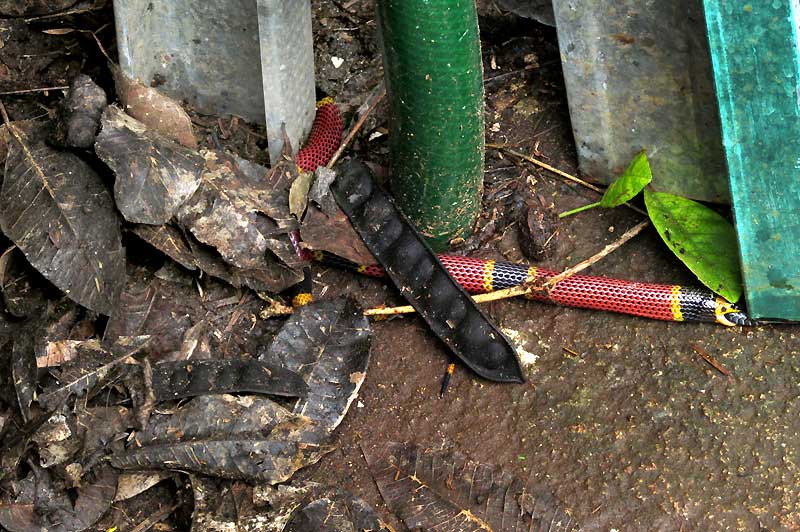
At 11AM, after 2½ hours of watching, seeing that the coral was making no more progress swallowing the snail-eater, I decided to lift the bar so that the feeding could end. A good biologist would have wanted to see it end without human intervention, but I'm not trying to be a scientist. I just want to pay attention to things and I don't worry about being empathetic with coral snakes. When the post was lifted, about a finger-length of the snail-eater's slender tail remained to be swallowed. By the time I could get the camera into position, only the black, red-tipped tip of the tail remained, sticking like a toothpick from the corner of the coral's mouth, as shown below:
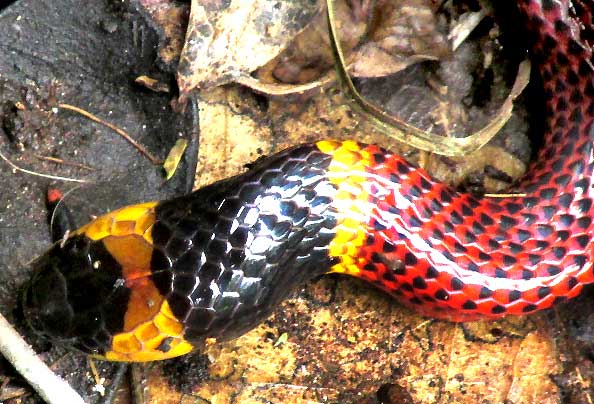
Notice that the end of the coral snake's tail ceases having yelow bands framing the red bands. The end is just black and red, exactly like the snail-eater's. I wish I knew if the coral's tail had been used to attract the snail-eater to within striking range...